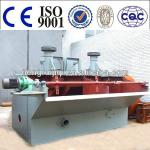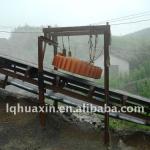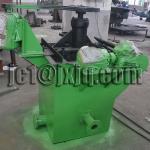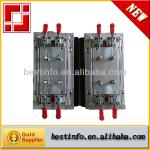Lead Zinc froth flotation/concentrating plant
| Condition:New | Type:Flotation Separator | Production Capacity:2-4 cbm per minute | Place of Origin:Shanghai China (Mainland) |
| Brand Name:Sievo | Model Number:SF-4 | Voltage:440v | Power(W):15/1.5KW |
| Dimension(L*W*H):1000x1000x1000 | Weight:4000KGS | Certification:CE,ISO9001 | Warranty:1 YEAR |
| After-sales Service Provided:Engineers available to service machinery overseas | NAME:FLOTATION CELL | USEAGE:Separating hydrophobic materials from hydrophilic |

Lead Zinc Froth flotation/ concentrating plant
Froth flotation is a process for selectively separating hydrophobic materials from hydrophilic.This is used in several processing industries. Historically this was first used in the mining industry, where it was one of the great enabling technologies of the 20th century.
It has been described as "the single most important operation used for the recovery and upgrading of sulfide ores". The development of froth flotation improved the recovery of valuable minerals, such as copper- and lead-bearing minerals.
Mining
Froth flotation is a process for separating minerals from gangue by taking advantage of differences in their hydrophobicity. Hydrophobicity differences between valuable minerals and waste gangue are increased through the use of surfactants and wetting agents.
The selective separation of the minerals makes processing complex (that is, mixed) ores economically feasible. The flotation process is used for the separation of a large range of sulfides, carbonates and oxides prior to further refinement.
Phosphates and coal are also upgraded (purified) by flotation technology.
Flotation stages
Roughing
The first stage is called roughing, which produces a rougher concentrate. The objective is to remove the maximum amount of the valuable mineral at as coarse a particle size as practical.
The finer an ore is ground, the greater the energy that is required, so it makes sense to only grind fine those particles that need fine grinding..
Complete liberation is not required for rougher flotation, only sufficient liberation to release enough gangue from the valuable mineral to get a high recovery.
The primary objective of roughing is to recover as much of the valuable minerals as possible, with less emphasis on the quality of the concentrate produced.
In some concentrators, there may be a preflotation step that precedes roughing. This is done when there are some undesirable materials, such as organic carbon, that readily float.
They are removed first to avoid them floating during roughing (and thus contaminating the rougher concentrate).
Cleaning
The rougher concentrate is normally subjected to further stages of flotation to reject more of the undesirable minerals that also reported to the froth, in a process known as cleaning. The product of cleaning is known as the cleaner concentrate or the final concentrate.
The objective of cleaning is to produce as high a concentrate grade as possible.
The rougher concentrate is often subject to further grinding (usually called regrinding) to get more complete liberation of the valuable minerals.
Because it is a smaller mass than that of the original ore, less energy is needed than would be necessary if the whole ore were reground.
Scavenging
The rougher flotation step is often followed by a scavenger flotation step that is applied to the rougher tailings. The objective is to recover any of the target minerals that were not recovered during the initial roughing stage.
This might be achieved by changing the flotation conditions to make them more rigorous than the initial roughing, or there might be some secondary grinding to provide further liberation.
The concentrate from the rougher scavengers could be returned to the rougher feed for refloating or
Similarly, the cleaning step may also be followed by a scavenging step performed on the cleaner tailings.
Parameter:
| Model | Volume (cbm) | Size of tank (L×W×H) (mm) | Impeller Dia. (mm) | IMPELLER SPEED (r/min) | Capacity (cbm/min) | Motor power (kw) | Air flow sucked (cbm/min) | Weight of singe tank (kg) |
| SF-0.15 | 0.15 | 500×500×600 | 200 | 536 | 0.06-0.18 | 1.5/0.55 | 0.8-1 | 269 |
| SF-0.37 | 0.37 | 700×700×750 | 296 | 386 | 0.2-0.4 | 1.5/0.55 | 0.8-1 | 468 |
| SF-0.7 | 0.7 | 820×900×950 | 350 | 400 | 0.3-0.9 | 3/1.1 | 0.8-1 | 805 |
| SF-1.2 | 1.2 | 1100×1100×1100 | 450 | 312 | 0.6-1.2 | 5.5/1.1 | 1-1.2 | 1373 |
| SF-2.8 | 2.8 | 1700×1600×1150 | 550 | 268 | 1.5-3.5 | 11/1.5 | 1-1.2 | 2138 |
| SF-4 | 4 | 1850×2050×1200 | 650 | 220 | 2--4 | 15/1.5 | 1-1.2 | 2582 |
| SF-8 | 8 | 2200×2900×1400 | 760 | 191 | 4--8 | 30/1.5 | 0.9-1 | 4129 |
| SF-10 | 10 | 2200×2900×1700 | 760 | 191 | 5--10 | 30/1.5 | 0.9-1 | 4486 |
| SF-16 | 16 | 2850×3800×1700 | 760 | 191 | 5--16 | 30×2/1.5 | 0.9-1 | 8320 |
| SF-20 | 20 | 2850×3800×2000 | 760 | 191 | 5--20 | 30×2/1.5 | 0.9-1 | 9828 |
Details:
Factory:
Delivery:

| Packaging Detail:Lead Zinc froth flotation/concentrating plant uses standard export packaging. |
| Delivery Detail:20days after receiving the deposit. |














